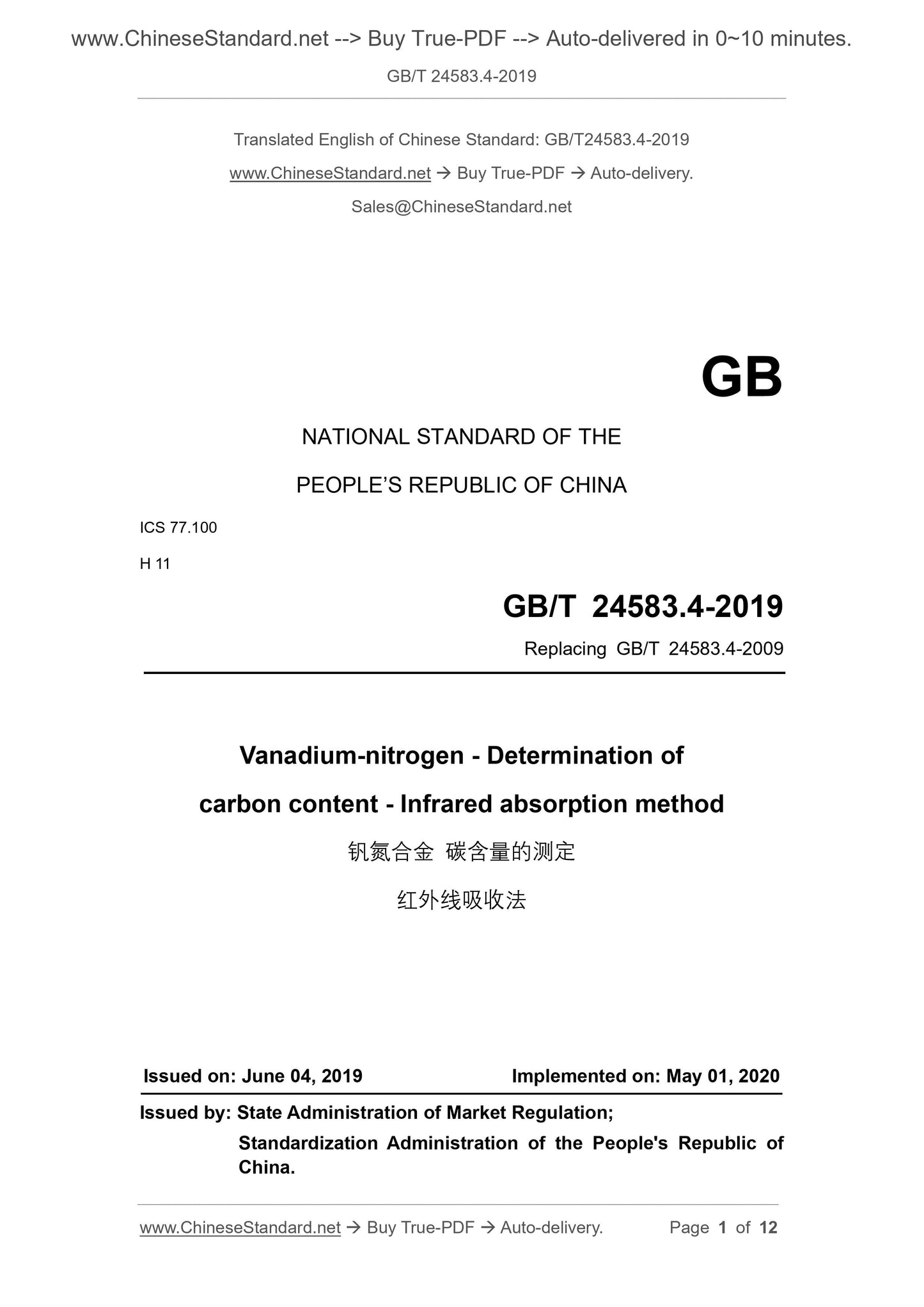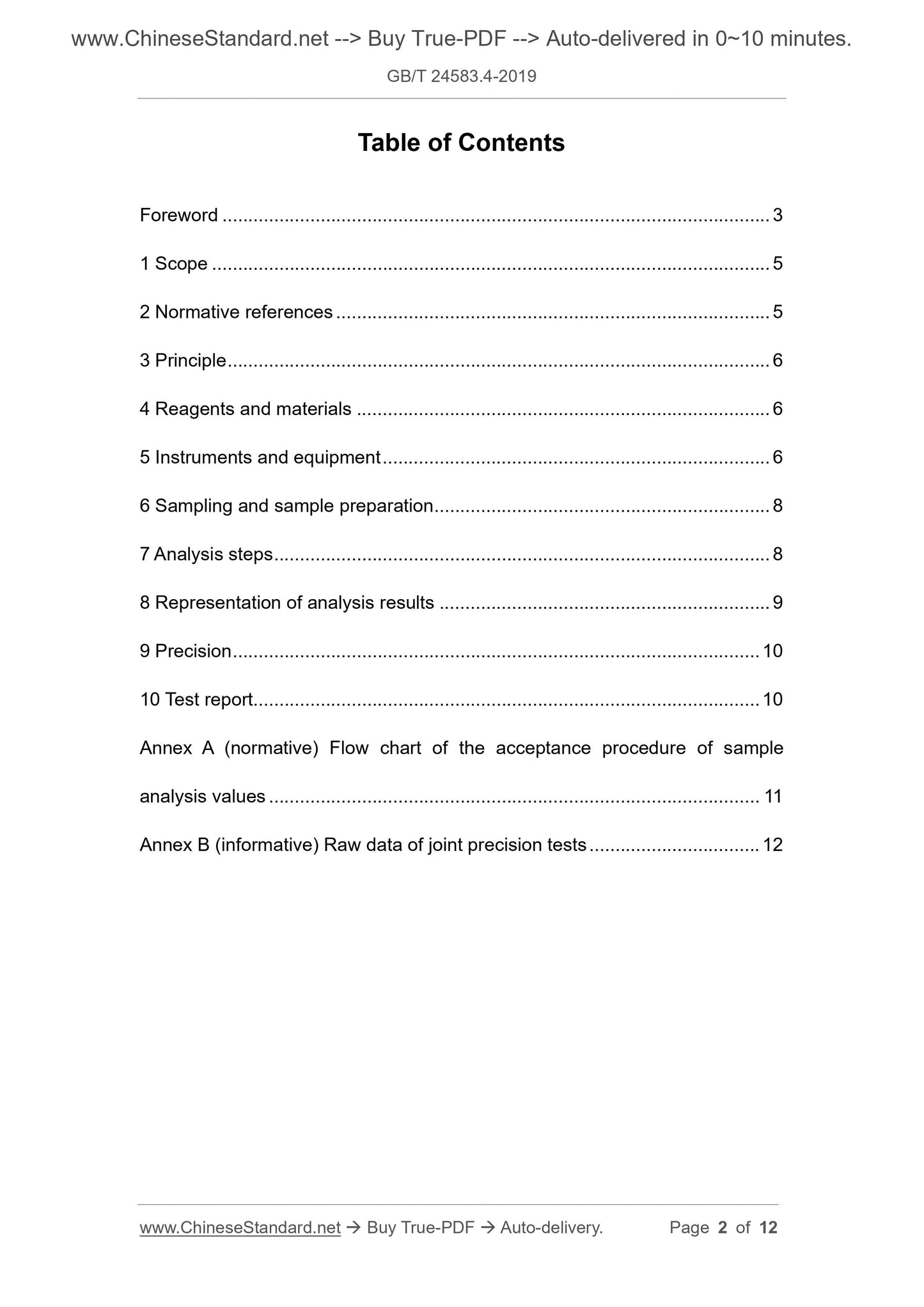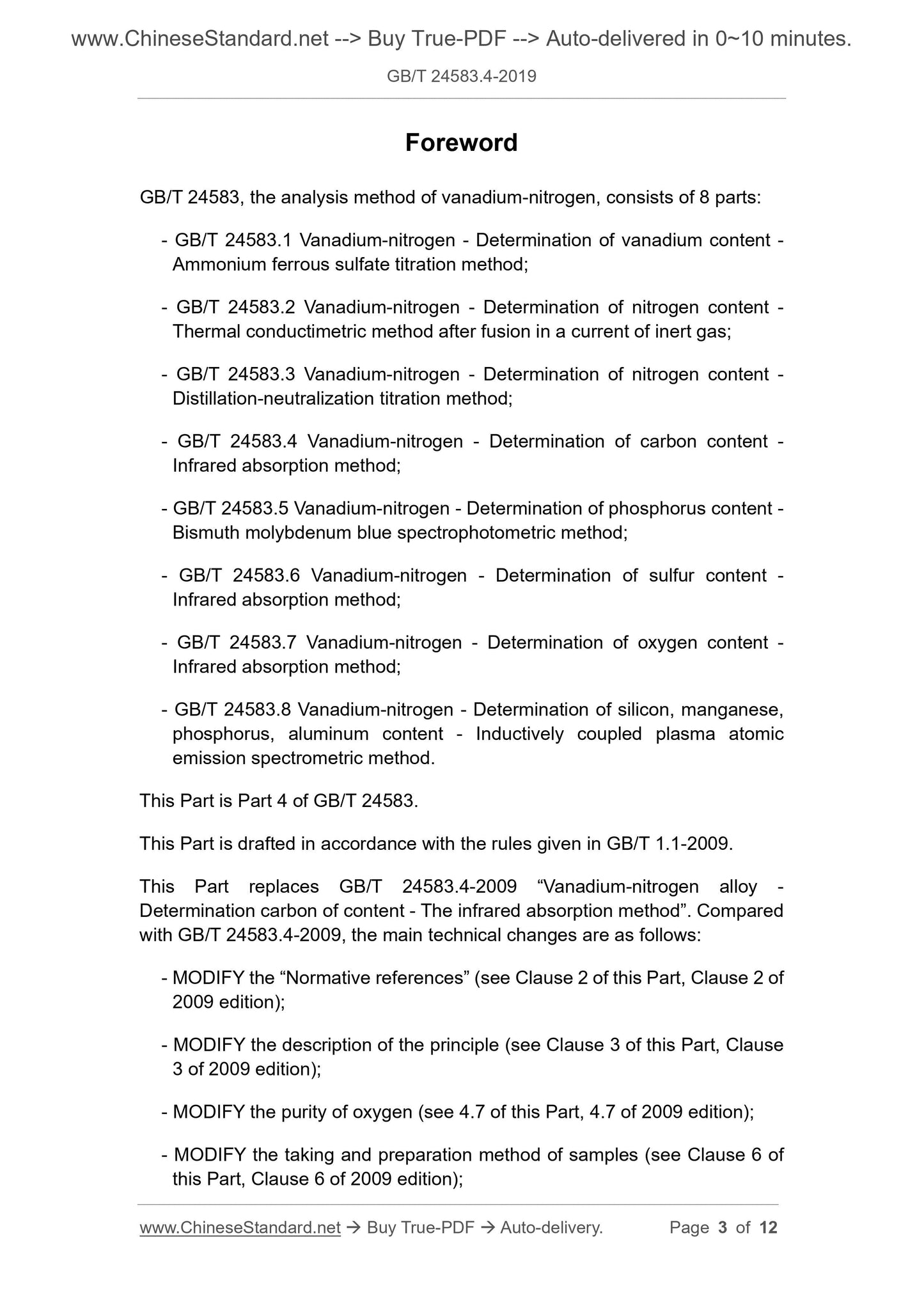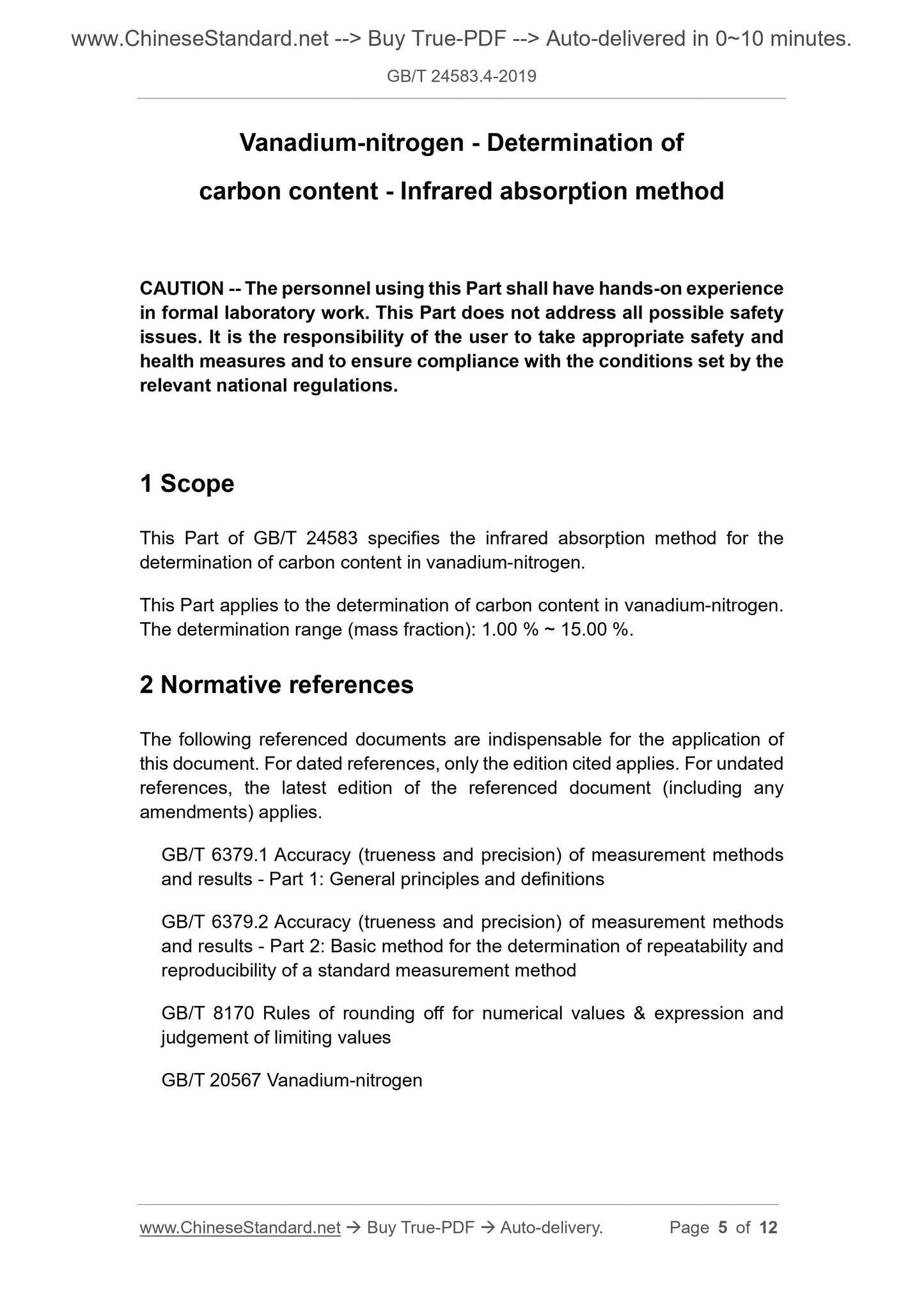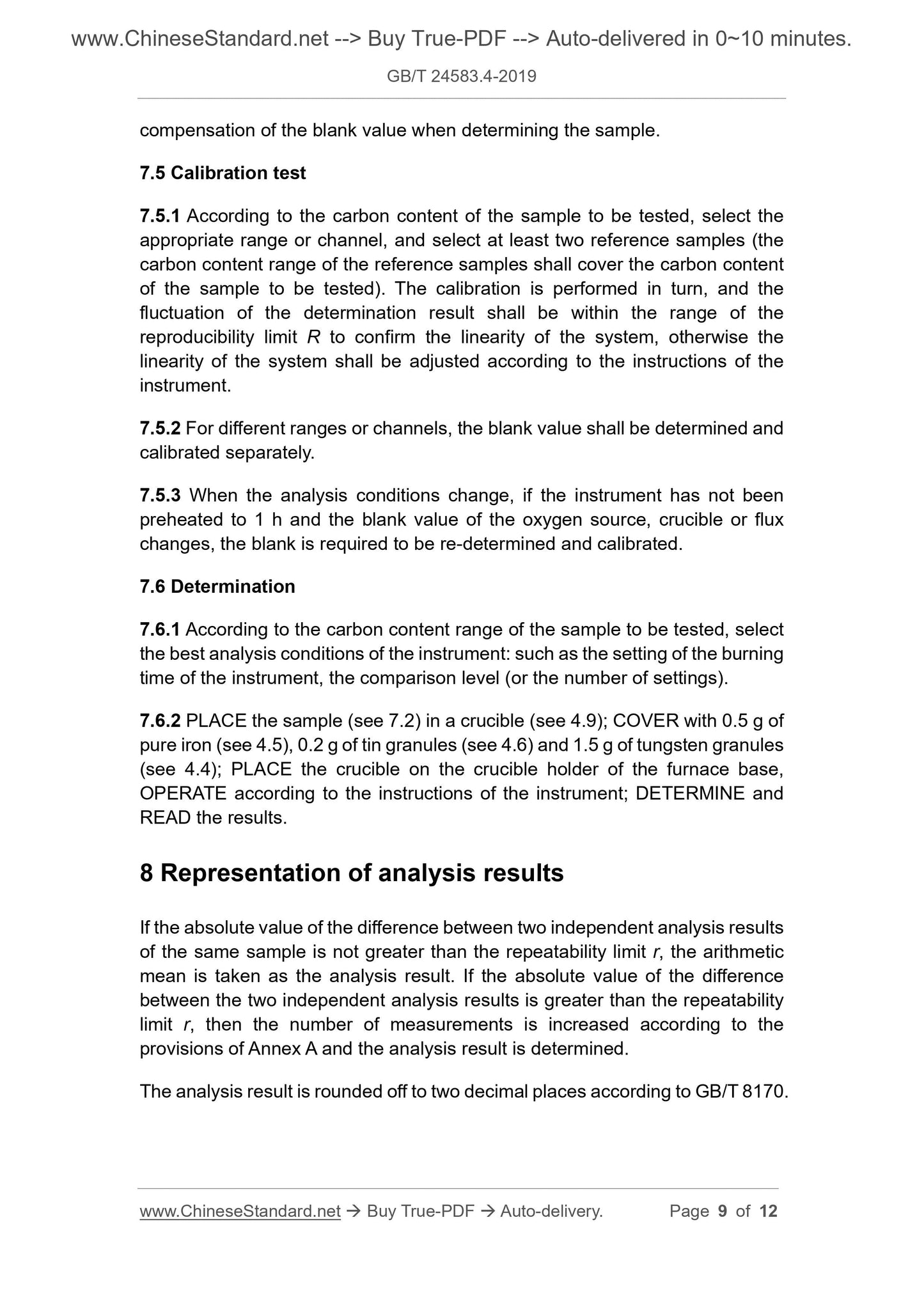1
/
of
5
www.ChineseStandard.us -- Field Test Asia Pte. Ltd.
GB/T 24583.4-2019 English PDF (GB/T24583.4-2019)
GB/T 24583.4-2019 English PDF (GB/T24583.4-2019)
Regular price
$150.00
Regular price
Sale price
$150.00
Unit price
/
per
Shipping calculated at checkout.
Couldn't load pickup availability
GB/T 24583.4-2019: Vanadium-nitrogen - Determination of carbon content - Infrared absorption method
Delivery: 9 seconds. Download (& Email) true-PDF + Invoice.
Get Quotation: Click GB/T 24583.4-2019 (Self-service in 1-minute)
Historical versions (Master-website): GB/T 24583.4-2019
Preview True-PDF (Reload/Scroll-down if blank)
GB/T 24583.4-2019
NATIONAL STANDARD OF THE
PEOPLE’S REPUBLIC OF CHINA
ICS 77.100
H 11
Replacing GB/T 24583.4-2009
Vanadium-nitrogen - Determination of
carbon content - Infrared absorption method
ISSUED ON: JUNE 04, 2019
IMPLEMENTED ON: MAY 01, 2020
Issued by: State Administration of Market Regulation;
Standardization Administration of the People's Republic of
China.
Table of Contents
Foreword ... 3
1 Scope ... 5
2 Normative references ... 5
3 Principle ... 6
4 Reagents and materials ... 6
5 Instruments and equipment ... 6
6 Sampling and sample preparation ... 8
7 Analysis steps ... 8
8 Representation of analysis results ... 9
9 Precision ... 10
10 Test report... 10
Annex A (normative) Flow chart of the acceptance procedure of sample
analysis values ... 11
Annex B (informative) Raw data of joint precision tests ... 12
Foreword
GB/T 24583, the analysis method of vanadium-nitrogen, consists of 8 parts:
- GB/T 24583.1 Vanadium-nitrogen - Determination of vanadium content -
Ammonium ferrous sulfate titration method;
- GB/T 24583.2 Vanadium-nitrogen - Determination of nitrogen content -
Thermal conductimetric method after fusion in a current of inert gas;
- GB/T 24583.3 Vanadium-nitrogen - Determination of nitrogen content -
Distillation-neutralization titration method;
- GB/T 24583.4 Vanadium-nitrogen - Determination of carbon content -
Infrared absorption method;
- GB/T 24583.5 Vanadium-nitrogen - Determination of phosphorus content -
Bismuth molybdenum blue spectrophotometric method;
- GB/T 24583.6 Vanadium-nitrogen - Determination of sulfur content -
Infrared absorption method;
- GB/T 24583.7 Vanadium-nitrogen - Determination of oxygen content -
Infrared absorption method;
- GB/T 24583.8 Vanadium-nitrogen - Determination of silicon, manganese,
phosphorus, aluminum content - Inductively coupled plasma atomic
emission spectrometric method.
This Part is Part 4 of GB/T 24583.
This Part is drafted in accordance with the rules given in GB/T 1.1-2009.
This Part replaces GB/T 24583.4-2009 “Vanadium-nitrogen alloy -
Determination carbon of content - The infrared absorption method”. Compared
with GB/T 24583.4-2009, the main technical changes are as follows:
- MODIFY the “Normative references” (see Clause 2 of this Part, Clause 2 of
2009 edition);
- MODIFY the description of the principle (see Clause 3 of this Part, Clause
3 of 2009 edition);
- MODIFY the purity of oxygen (see 4.7 of this Part, 4.7 of 2009 edition);
- MODIFY the taking and preparation method of samples (see Clause 6 of
this Part, Clause 6 of 2009 edition);
Vanadium-nitrogen - Determination of
carbon content - Infrared absorption method
CAUTION -- The personnel using this Part shall have hands-on experience
in formal laboratory work. This Part does not address all possible safety
issues. It is the responsibility of the user to take appropriate safety and
health measures and to ensure compliance with the conditions set by the
relevant national regulations.
1 Scope
This Part of GB/T 24583 specifies the infrared absorption method for the
determination of carbon content in vanadium-nitrogen.
This Part applies to the determination of carbon content in vanadium-nitrogen.
The determination range (mass fraction): 1.00 % ~ 15.00 %.
2 Normative references
The following referenced documents are indispensable for the application of
this document. For dated references, only the edition cited applies. For undated
references, the latest edition of the referenced document (including any
amendments) applies.
GB/T 6379.1 Accuracy (trueness and precision) of measurement methods
and results - Part 1: General principles and definitions
GB/T 6379.2 Accuracy (trueness and precision) of measurement methods
and results - Part 2: Basic method for the determination of repeatability and
reproducibility of a standard measurement method
GB/T 8170 Rules of rounding off for numerical values and expression and
judgement of limiting values
GB/T 20567 Vanadium-nitrogen
compensation of the blank value when determining the sample.
7.5 Calibration test
7.5.1 According to the carbon content of the sample to be tested, select the
appropriate range or channel, and select at least two reference samples (the
carbon content range of the reference samples shall cover the carbon content
of the sample to be tested). The calibration is performed in turn, and the
fluctuation of the determination result shall be within the range of the
reproducibility limit R to confirm the linearity of the system, otherwise the
linearity of the system shall be adjusted according to the instructions of the
instrument.
7.5.2 For different ranges or channels, the blank value shall be determined and
calibrated separately.
7.5.3 When the analysis conditions change, if the instrument has not been
preheated to 1 h and the blank value of the oxygen source, crucible or flux
changes, the blank is required to be re-determined and calibrated.
7.6 Determination
7.6.1 According to the carbon content range of the sample to be tested, select
the best analysis conditions of the instrument: such as the setting of the burning
time of the instrument, the comparison level (or the number of settings).
7.6.2 PLACE the sample (see 7.2) in a crucible (see 4.9); COVER with 0.5 g of
pure iron (see 4.5), 0.2 g of tin granules (see 4.6) and 1.5 g of tungsten granules
(see 4.4); PLACE the crucible on the crucible holder of the furnace base,
OPERATE according to the instructions of the instrument; DETERMINE and
READ the results.
8 Representation of analysis results
If the absolute value of the difference between two independent analysis results
of the same sample is not greater than the repeatability limit r, the arithmetic
mean is taken as the analysis result. If the absolute value of the difference
between the two independent analysis results is greater than the repeatability
limit r, then the number of measurements is increased according to the
provisions of Annex A and the analysis result is determined.
The analysis result is rounded off to two decimal places according to GB/T 8170.
GB/T 24583.4-2019
NATIONAL STANDARD OF THE
PEOPLE’S REPUBLIC OF CHINA
ICS 77.100
H 11
Replacing GB/T 24583.4-2009
Vanadium-nitrogen - Determination of
carbon content - Infrared absorption method
ISSUED ON: JUNE 04, 2019
IMPLEMENTED ON: MAY 01, 2020
Issued by: State Administration of Market Regulation;
Standardization Administration of the People's Republic of
China.
Table of Contents
Foreword ... 3
1 Scope ... 5
2 Normative references ... 5
3 Principle ... 6
4 Reagents and materials ... 6
5 Instruments and equipment ... 6
6 Sampling and sample preparation ... 8
7 Analysis steps ... 8
8 Representation of analysis results ... 9
9 Precision ... 10
10 Test report... 10
Annex A (normative) Flow chart of the acceptance procedure of sample
analysis values ... 11
Annex B (informative) Raw data of joint precision tests ... 12
Foreword
GB/T 24583, the analysis method of vanadium-nitrogen, consists of 8 parts:
- GB/T 24583.1 Vanadium-nitrogen - Determination of vanadium content -
Ammonium ferrous sulfate titration method;
- GB/T 24583.2 Vanadium-nitrogen - Determination of nitrogen content -
Thermal conductimetric method after fusion in a current of inert gas;
- GB/T 24583.3 Vanadium-nitrogen - Determination of nitrogen content -
Distillation-neutralization titration method;
- GB/T 24583.4 Vanadium-nitrogen - Determination of carbon content -
Infrared absorption method;
- GB/T 24583.5 Vanadium-nitrogen - Determination of phosphorus content -
Bismuth molybdenum blue spectrophotometric method;
- GB/T 24583.6 Vanadium-nitrogen - Determination of sulfur content -
Infrared absorption method;
- GB/T 24583.7 Vanadium-nitrogen - Determination of oxygen content -
Infrared absorption method;
- GB/T 24583.8 Vanadium-nitrogen - Determination of silicon, manganese,
phosphorus, aluminum content - Inductively coupled plasma atomic
emission spectrometric method.
This Part is Part 4 of GB/T 24583.
This Part is drafted in accordance with the rules given in GB/T 1.1-2009.
This Part replaces GB/T 24583.4-2009 “Vanadium-nitrogen alloy -
Determination carbon of content - The infrared absorption method”. Compared
with GB/T 24583.4-2009, the main technical changes are as follows:
- MODIFY the “Normative references” (see Clause 2 of this Part, Clause 2 of
2009 edition);
- MODIFY the description of the principle (see Clause 3 of this Part, Clause
3 of 2009 edition);
- MODIFY the purity of oxygen (see 4.7 of this Part, 4.7 of 2009 edition);
- MODIFY the taking and preparation method of samples (see Clause 6 of
this Part, Clause 6 of 2009 edition);
Vanadium-nitrogen - Determination of
carbon content - Infrared absorption method
CAUTION -- The personnel using this Part shall have hands-on experience
in formal laboratory work. This Part does not address all possible safety
issues. It is the responsibility of the user to take appropriate safety and
health measures and to ensure compliance with the conditions set by the
relevant national regulations.
1 Scope
This Part of GB/T 24583 specifies the infrared absorption method for the
determination of carbon content in vanadium-nitrogen.
This Part applies to the determination of carbon content in vanadium-nitrogen.
The determination range (mass fraction): 1.00 % ~ 15.00 %.
2 Normative references
The following referenced documents are indispensable for the application of
this document. For dated references, only the edition cited applies. For undated
references, the latest edition of the referenced document (including any
amendments) applies.
GB/T 6379.1 Accuracy (trueness and precision) of measurement methods
and results - Part 1: General principles and definitions
GB/T 6379.2 Accuracy (trueness and precision) of measurement methods
and results - Part 2: Basic method for the determination of repeatability and
reproducibility of a standard measurement method
GB/T 8170 Rules of rounding off for numerical values and expression and
judgement of limiting values
GB/T 20567 Vanadium-nitrogen
compensation of the blank value when determining the sample.
7.5 Calibration test
7.5.1 According to the carbon content of the sample to be tested, select the
appropriate range or channel, and select at least two reference samples (the
carbon content range of the reference samples shall cover the carbon content
of the sample to be tested). The calibration is performed in turn, and the
fluctuation of the determination result shall be within the range of the
reproducibility limit R to confirm the linearity of the system, otherwise the
linearity of the system shall be adjusted according to the instructions of the
instrument.
7.5.2 For different ranges or channels, the blank value shall be determined and
calibrated separately.
7.5.3 When the analysis conditions change, if the instrument has not been
preheated to 1 h and the blank value of the oxygen source, crucible or flux
changes, the blank is required to be re-determined and calibrated.
7.6 Determination
7.6.1 According to the carbon content range of the sample to be tested, select
the best analysis conditions of the instrument: such as the setting of the burning
time of the instrument, the comparison level (or the number of settings).
7.6.2 PLACE the sample (see 7.2) in a crucible (see 4.9); COVER with 0.5 g of
pure iron (see 4.5), 0.2 g of tin granules (see 4.6) and 1.5 g of tungsten granules
(see 4.4); PLACE the crucible on the crucible holder of the furnace base,
OPERATE according to the instructions of the instrument; DETERMINE and
READ the results.
8 Representation of analysis results
If the absolute value of the difference between two independent analysis results
of the same sample is not greater than the repeatability limit r, the arithmetic
mean is taken as the analysis result. If the absolute value of the difference
between the two independent analysis results is greater than the repeatability
limit r, then the number of measurements is increased according to the
provisions of Annex A and the analysis result is determined.
The analysis result is rounded off to two decimal places according to GB/T 8170.
Delivery: 9 seconds. Download (& Email) true-PDF + Invoice.
Get Quotation: Click GB/T 24583.4-2019 (Self-service in 1-minute)
Historical versions (Master-website): GB/T 24583.4-2019
Preview True-PDF (Reload/Scroll-down if blank)
GB/T 24583.4-2019
NATIONAL STANDARD OF THE
PEOPLE’S REPUBLIC OF CHINA
ICS 77.100
H 11
Replacing GB/T 24583.4-2009
Vanadium-nitrogen - Determination of
carbon content - Infrared absorption method
ISSUED ON: JUNE 04, 2019
IMPLEMENTED ON: MAY 01, 2020
Issued by: State Administration of Market Regulation;
Standardization Administration of the People's Republic of
China.
Table of Contents
Foreword ... 3
1 Scope ... 5
2 Normative references ... 5
3 Principle ... 6
4 Reagents and materials ... 6
5 Instruments and equipment ... 6
6 Sampling and sample preparation ... 8
7 Analysis steps ... 8
8 Representation of analysis results ... 9
9 Precision ... 10
10 Test report... 10
Annex A (normative) Flow chart of the acceptance procedure of sample
analysis values ... 11
Annex B (informative) Raw data of joint precision tests ... 12
Foreword
GB/T 24583, the analysis method of vanadium-nitrogen, consists of 8 parts:
- GB/T 24583.1 Vanadium-nitrogen - Determination of vanadium content -
Ammonium ferrous sulfate titration method;
- GB/T 24583.2 Vanadium-nitrogen - Determination of nitrogen content -
Thermal conductimetric method after fusion in a current of inert gas;
- GB/T 24583.3 Vanadium-nitrogen - Determination of nitrogen content -
Distillation-neutralization titration method;
- GB/T 24583.4 Vanadium-nitrogen - Determination of carbon content -
Infrared absorption method;
- GB/T 24583.5 Vanadium-nitrogen - Determination of phosphorus content -
Bismuth molybdenum blue spectrophotometric method;
- GB/T 24583.6 Vanadium-nitrogen - Determination of sulfur content -
Infrared absorption method;
- GB/T 24583.7 Vanadium-nitrogen - Determination of oxygen content -
Infrared absorption method;
- GB/T 24583.8 Vanadium-nitrogen - Determination of silicon, manganese,
phosphorus, aluminum content - Inductively coupled plasma atomic
emission spectrometric method.
This Part is Part 4 of GB/T 24583.
This Part is drafted in accordance with the rules given in GB/T 1.1-2009.
This Part replaces GB/T 24583.4-2009 “Vanadium-nitrogen alloy -
Determination carbon of content - The infrared absorption method”. Compared
with GB/T 24583.4-2009, the main technical changes are as follows:
- MODIFY the “Normative references” (see Clause 2 of this Part, Clause 2 of
2009 edition);
- MODIFY the description of the principle (see Clause 3 of this Part, Clause
3 of 2009 edition);
- MODIFY the purity of oxygen (see 4.7 of this Part, 4.7 of 2009 edition);
- MODIFY the taking and preparation method of samples (see Clause 6 of
this Part, Clause 6 of 2009 edition);
Vanadium-nitrogen - Determination of
carbon content - Infrared absorption method
CAUTION -- The personnel using this Part shall have hands-on experience
in formal laboratory work. This Part does not address all possible safety
issues. It is the responsibility of the user to take appropriate safety and
health measures and to ensure compliance with the conditions set by the
relevant national regulations.
1 Scope
This Part of GB/T 24583 specifies the infrared absorption method for the
determination of carbon content in vanadium-nitrogen.
This Part applies to the determination of carbon content in vanadium-nitrogen.
The determination range (mass fraction): 1.00 % ~ 15.00 %.
2 Normative references
The following referenced documents are indispensable for the application of
this document. For dated references, only the edition cited applies. For undated
references, the latest edition of the referenced document (including any
amendments) applies.
GB/T 6379.1 Accuracy (trueness and precision) of measurement methods
and results - Part 1: General principles and definitions
GB/T 6379.2 Accuracy (trueness and precision) of measurement methods
and results - Part 2: Basic method for the determination of repeatability and
reproducibility of a standard measurement method
GB/T 8170 Rules of rounding off for numerical values and expression and
judgement of limiting values
GB/T 20567 Vanadium-nitrogen
compensation of the blank value when determining the sample.
7.5 Calibration test
7.5.1 According to the carbon content of the sample to be tested, select the
appropriate range or channel, and select at least two reference samples (the
carbon content range of the reference samples shall cover the carbon content
of the sample to be tested). The calibration is performed in turn, and the
fluctuation of the determination result shall be within the range of the
reproducibility limit R to confirm the linearity of the system, otherwise the
linearity of the system shall be adjusted according to the instructions of the
instrument.
7.5.2 For different ranges or channels, the blank value shall be determined and
calibrated separately.
7.5.3 When the analysis conditions change, if the instrument has not been
preheated to 1 h and the blank value of the oxygen source, crucible or flux
changes, the blank is required to be re-determined and calibrated.
7.6 Determination
7.6.1 According to the carbon content range of the sample to be tested, select
the best analysis conditions of the instrument: such as the setting of the burning
time of the instrument, the comparison level (or the number of settings).
7.6.2 PLACE the sample (see 7.2) in a crucible (see 4.9); COVER with 0.5 g of
pure iron (see 4.5), 0.2 g of tin granules (see 4.6) and 1.5 g of tungsten granules
(see 4.4); PLACE the crucible on the crucible holder of the furnace base,
OPERATE according to the instructions of the instrument; DETERMINE and
READ the results.
8 Representation of analysis results
If the absolute value of the difference between two independent analysis results
of the same sample is not greater than the repeatability limit r, the arithmetic
mean is taken as the analysis result. If the absolute value of the difference
between the two independent analysis results is greater than the repeatability
limit r, then the number of measurements is increased according to the
provisions of Annex A and the analysis result is determined.
The analysis result is rounded off to two decimal places according to GB/T 8170.
GB/T 24583.4-2019
NATIONAL STANDARD OF THE
PEOPLE’S REPUBLIC OF CHINA
ICS 77.100
H 11
Replacing GB/T 24583.4-2009
Vanadium-nitrogen - Determination of
carbon content - Infrared absorption method
ISSUED ON: JUNE 04, 2019
IMPLEMENTED ON: MAY 01, 2020
Issued by: State Administration of Market Regulation;
Standardization Administration of the People's Republic of
China.
Table of Contents
Foreword ... 3
1 Scope ... 5
2 Normative references ... 5
3 Principle ... 6
4 Reagents and materials ... 6
5 Instruments and equipment ... 6
6 Sampling and sample preparation ... 8
7 Analysis steps ... 8
8 Representation of analysis results ... 9
9 Precision ... 10
10 Test report... 10
Annex A (normative) Flow chart of the acceptance procedure of sample
analysis values ... 11
Annex B (informative) Raw data of joint precision tests ... 12
Foreword
GB/T 24583, the analysis method of vanadium-nitrogen, consists of 8 parts:
- GB/T 24583.1 Vanadium-nitrogen - Determination of vanadium content -
Ammonium ferrous sulfate titration method;
- GB/T 24583.2 Vanadium-nitrogen - Determination of nitrogen content -
Thermal conductimetric method after fusion in a current of inert gas;
- GB/T 24583.3 Vanadium-nitrogen - Determination of nitrogen content -
Distillation-neutralization titration method;
- GB/T 24583.4 Vanadium-nitrogen - Determination of carbon content -
Infrared absorption method;
- GB/T 24583.5 Vanadium-nitrogen - Determination of phosphorus content -
Bismuth molybdenum blue spectrophotometric method;
- GB/T 24583.6 Vanadium-nitrogen - Determination of sulfur content -
Infrared absorption method;
- GB/T 24583.7 Vanadium-nitrogen - Determination of oxygen content -
Infrared absorption method;
- GB/T 24583.8 Vanadium-nitrogen - Determination of silicon, manganese,
phosphorus, aluminum content - Inductively coupled plasma atomic
emission spectrometric method.
This Part is Part 4 of GB/T 24583.
This Part is drafted in accordance with the rules given in GB/T 1.1-2009.
This Part replaces GB/T 24583.4-2009 “Vanadium-nitrogen alloy -
Determination carbon of content - The infrared absorption method”. Compared
with GB/T 24583.4-2009, the main technical changes are as follows:
- MODIFY the “Normative references” (see Clause 2 of this Part, Clause 2 of
2009 edition);
- MODIFY the description of the principle (see Clause 3 of this Part, Clause
3 of 2009 edition);
- MODIFY the purity of oxygen (see 4.7 of this Part, 4.7 of 2009 edition);
- MODIFY the taking and preparation method of samples (see Clause 6 of
this Part, Clause 6 of 2009 edition);
Vanadium-nitrogen - Determination of
carbon content - Infrared absorption method
CAUTION -- The personnel using this Part shall have hands-on experience
in formal laboratory work. This Part does not address all possible safety
issues. It is the responsibility of the user to take appropriate safety and
health measures and to ensure compliance with the conditions set by the
relevant national regulations.
1 Scope
This Part of GB/T 24583 specifies the infrared absorption method for the
determination of carbon content in vanadium-nitrogen.
This Part applies to the determination of carbon content in vanadium-nitrogen.
The determination range (mass fraction): 1.00 % ~ 15.00 %.
2 Normative references
The following referenced documents are indispensable for the application of
this document. For dated references, only the edition cited applies. For undated
references, the latest edition of the referenced document (including any
amendments) applies.
GB/T 6379.1 Accuracy (trueness and precision) of measurement methods
and results - Part 1: General principles and definitions
GB/T 6379.2 Accuracy (trueness and precision) of measurement methods
and results - Part 2: Basic method for the determination of repeatability and
reproducibility of a standard measurement method
GB/T 8170 Rules of rounding off for numerical values and expression and
judgement of limiting values
GB/T 20567 Vanadium-nitrogen
compensation of the blank value when determining the sample.
7.5 Calibration test
7.5.1 According to the carbon content of the sample to be tested, select the
appropriate range or channel, and select at least two reference samples (the
carbon content range of the reference samples shall cover the carbon content
of the sample to be tested). The calibration is performed in turn, and the
fluctuation of the determination result shall be within the range of the
reproducibility limit R to confirm the linearity of the system, otherwise the
linearity of the system shall be adjusted according to the instructions of the
instrument.
7.5.2 For different ranges or channels, the blank value shall be determined and
calibrated separately.
7.5.3 When the analysis conditions change, if the instrument has not been
preheated to 1 h and the blank value of the oxygen source, crucible or flux
changes, the blank is required to be re-determined and calibrated.
7.6 Determination
7.6.1 According to the carbon content range of the sample to be tested, select
the best analysis conditions of the instrument: such as the setting of the burning
time of the instrument, the comparison level (or the number of settings).
7.6.2 PLACE the sample (see 7.2) in a crucible (see 4.9); COVER with 0.5 g of
pure iron (see 4.5), 0.2 g of tin granules (see 4.6) and 1.5 g of tungsten granules
(see 4.4); PLACE the crucible on the crucible holder of the furnace base,
OPERATE according to the instructions of the instrument; DETERMINE and
READ the results.
8 Representation of analysis results
If the absolute value of the difference between two independent analysis results
of the same sample is not greater than the repeatability limit r, the arithmetic
mean is taken as the analysis result. If the absolute value of the difference
between the two independent analysis results is greater than the repeatability
limit r, then the number of measurements is increased according to the
provisions of Annex A and the analysis result is determined.
The analysis result is rounded off to two decimal places according to GB/T 8170.
Share
